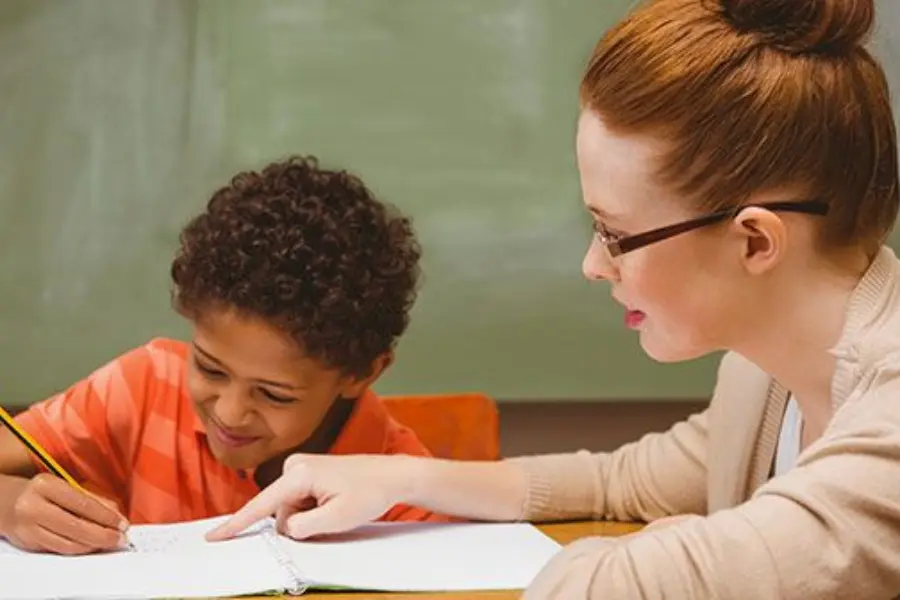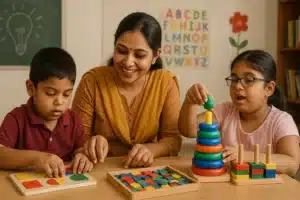
Source: freepik
Our Brain is like a super-machine with certain designated areas overseeing certain functions. At times the areas in the brain that handle the processing of mathematical concepts are affected due to reasons the child finds it difficult to perform mathematical problems, understanding concepts of order and sequencing. This condition in which the child’s basic math skills are affected is called Dyscalculia. However, these challenges do not ascertain that children with dyscalculia are less intelligent or with lower IQ.
For those looking to provide effective assistance, Dyscalculia Courses can offer valuable strategies and tools. Vidhyanidhi Education Society (Govt. Regd.) provides specialized Dyscalculia Courses designed to equip educators and caregivers with the knowledge to help individuals overcome these challenges and succeed.
What are Various Dyscalculia Teaching Strategies?
Supporting students with dyscalculia requires a thoughtful approach and strategies addressing their unique math challenges. By applying effective Dyscalculia Teaching Strategies, educators can help these students build confidence and improve their skills.
Here are detailed approaches to teaching students with dyscalculia:
Curate and offer tailor-made Instructions
Depending on the learning styles of the child devise instructions that can help the child understand the concept better and clearly. When children with dyscalculia are explained topics in a simplified manner they grasp the topics better which helps in understanding the connecting topics. For students with dyscalculia, this means presenting information using simplified language, clear explanations, and visual demonstrations. For example, when teaching addition, a teacher might use number lines, diagrams, and simple storytelling to ensure all students grasp the concept. This strategy ensures students learn at their own pace without altering the lesson content.
Break Lessons into Manageable Steps
Chunking is a concept in which the entire problem is broken down into smaller steps. This method is the most effective approach for helping children with dyscalculia build the best foundation for basic maths. When the foundational knowledge is well understood it becomes easier to continue with the later topics. Before introducing a new topic, teachers can briefly review earlier lessons to create a seamless transition. For instance, when teaching multiplication, a teacher might first review addition and repeated counting to bridge the gap.
Incorporate Visual Aids and Manipulatives
Charts, graphs, and actual objects are examples of visual aids that can help make abstract mathematical ideas more relatable. For younger students, manipulatives like fraction circles, blocks, or colorful beads work especially well. For example, using a large square to demonstrate exponents allows students to visualize and count units, making the concept of squaring numbers clearer. Visual aids also help students understand patterns, relationships, and processes, reducing confusion.
For more details on the LD Course Call/Whatsapp at +919321024137 / +919869866277
To download the brochure of the LD Course, Click Here!

Source: pinterest
Revise on a timely basis.
For children with dyscalculia or any other learning disability, regular revision is extremely important so that the child grasps the topics better. Reviewing earlier material ensures that students retain crucial knowledge, making it easier for them to tackle new concepts. Micro-lessons—short, focused sessions on specific topics—can be integrated into class time without disrupting the flow of new instruction. For instance, a five-minute recap of fractions before introducing percentages can prepare students effectively.
Connect Math to Real-Life Applications
Relating math to real-world scenarios can make it more meaningful and less abstract for students with dyscalculia. Children often learn through activities that interest them on a day-to-day basis in which they are actively involved. E.g. children love to visit local shops to buy sweets, chocolates, or even stationery. Children should be encouraged to add the prices of such things and understand mathematical operations like addition better. The child can be involved in simple activities cooking e.g. while making Pizza the child can be taught the concepts of ratios and fractions engage kinaesthetic learners and show how math applies outside the classroom.
Encourage Self-Teaching
Self-teaching allows students to explain concepts in their own words, reinforcing their understanding. This technique encourages active participation and helps teachers identify areas where students need additional support. For instance, after a lesson on subtraction, a student might explain the steps back to the teacher, clarifying any misunderstandings in the process.
Promote a conducive learning atmosphere.
A child can learn well only when he feels safe and appreciated in any environment. So the teacher has to give special attention to creating a classroom atmosphere that helps every child be on the same level as their classmates without being looked down upon or bullied. Teachers should have discussions on learning difficulties that foster a spirit of empathy amongst children where they are emotionally receptive to the struggles of special children.
For example, during a lesson on geometry, providing access to digital tools for visualization ensures students stay engaged without feeling overwhelmed.
Educators seeking to improve their teaching skills can join specialized Dyscalculia Courses offered by institutions like Vidhyanidhi Education Society. The Learning disabilities program offered at Vidhyanidhi Education Society (Govt. Regd.) are top-notch educational program with a comprehensive updated curriculum and ample practical classroom exposure that gives the trainees insights into the realms of real classroom scenarios helping children with dyscalculia overcome their learning challenges effectively.
For more details on the LD Course Call/Whatsapp at +919321024137 / +919869866277
To download the brochure of the LD Course, Click Here!

Source: behaviourhelp
Dyslexia Dysgraphia Dyscalculia
As the basic skills of reading, writing, and mathematics form the foundation of a successful lifetime of learning gaining deeper knowledge of crucial aspects of Dyslexia Dysgraphia Dyscalculia is a must. Only when the teacher has acquired knowledge of various learning disabilities, and their effects they can offer precise academic support in the areas that need urgent attention. These conditions are not reflections of intellect but result from neurological differences that impact learning.
Here’s an overview of Dyslexia Dysgraphia Dyscalculia and how to help children overcome related challenges:
Dyslexia
Dyslexia is a learning disorder that is caused when the brain cannot process the information that it receives due to which the child cannot decode the words properly leading to poor English skills and takes a dislike of reading.
- Teaching tactics for helping dyslexia children
- Using multi-sensorial strategies that focus on the strengths of the child for better learning.
- Providing extra time for reading and writing tasks.
- Utilizing audiobooks and reading aloud to enhance comprehension.
Dysgraphia
Dysgraphia affects the mechanical procedure of writing, like handwriting and typing, making it difficult for kids to express their ideas clearly. It can be linked to fine motor skill issues or spatial awareness difficulties.
Support strategies include:
- Occupational therapy to enhance motor skills.
- Tools like pencil grips or talk-to-text programs.
- Breaking writing tasks into smaller steps and allowing oral responses.
Dyscalculia
Dyscalculia is a math-related learning disorder, that makes it hard to understand numbers, symbols, and concepts like size or quantity. Children may also struggle to apply math skills in problem-solving.
Effective Dyscalculia Teaching Strategies include:
- Using multisensory methods, such as counting with objects or visual aids.
- Providing tools like calculators or simplified assignments.
- Connecting math concepts to real-life activities like cooking or shopping.
For educators and caregivers, specialized Dyscalculia Courses provide valuable techniques to support students effectively. Courses like those offered by Vidhyanidhi Education Society equip individuals with the knowledge and tools to make a meaningful difference in the lives of children with learning disabilities.
Join Vidhyanidhi Education Society’s LD Course today to empower young minds!
For more details on the LD Course Call/Whatsapp at +919321024137 / +919869866277
To download the brochure of the LD Course, Click Here!
FAQs
What are the top 5 learning difficulties?
The 5 learning difficulties that top the list affecting children in the early age group hampering their learning skills are dyslexia, ADHD, dyscalculia, dysgraphia, and dyspraxia.
How can teachers help students with learning disabilities?
Students with learning disabilities can be helped by special educators by applying interactive strategies and teaching methods that help them learn in their learning style.
How to identify the learning difficulties of students?
Identify learning difficulties in students through signs like reading/writing issues, math struggles, poor memory, attention lapses, trouble following directions, or poor coordination.



